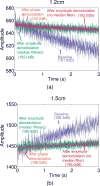Adaptive Clutter Demodulation for Non-Contrast Ultrasound Perfusion Imaging
- PMID: 28622670
- PMCID: PMC5605932
- DOI: 10.1109/TMI.2017.2714901
Adaptive Clutter Demodulation for Non-Contrast Ultrasound Perfusion Imaging
Abstract
Conventional Doppler ultrasound is useful for visualizing fast blood flow in large resolvable vessels. However, frame rate and tissue clutter caused by movement of the patient or sonographer make visualizing slow flow with ultrasound difficult. Patient and sonographer motion causes spectral broadening of the clutter signal, which limits ultrasound's sensitivity to velocities greater than 5-10 mm/s for typical clinical imaging frequencies. To address this, we propose a clutter filtering technique that may increase the sensitivity of Doppler measurements to at least as low as 0.52 mm/s. The proposed technique uses plane wave imaging and an adaptive frequency and amplitude demodulation scheme to decrease the bandwidth of tissue clutter. To test the performance of the adaptive demodulation method at suppressing tissue clutter bandwidths due to sonographer hand motion alone, six volunteer subjects acquired data from a stationary phantom. Additionally, to test in vivo feasibility, arterial occlusion and muscle contraction studies were performed to assess the efficiency of the proposed filter at preserving signals from blood velocities 2 mm/s or greater at a 7.8 MHz center frequency. The hand motion study resulted in initial average bandwidths of 175 Hz (8.60mm/s), which were decreased to 10.5 Hz (0.52 mm/s) at -60 dB using our approach. The in vivo power Doppler studies resulted in 4.73 dB and 4.80 dB dynamic ranges of the blood flow with the proposed filter and 0.15 dB and 0.16 dB dynamic ranges of the blood flow with a conventional 50 Hz high-pass filter for the occlusion and contraction studies, respectively.
Figures












References
-
- Tremblay-Darveau C, Williams R, Milot L, Bruce M, Burns PN. Combined perfusion and doppler imaging using plane-wave nonlinear detection and microbubble contrast agents. IEEE Transactions on Ultrasonics, Ferroelectrics and Frequency Control. 2014;61:1988–2000. - PubMed
-
- Jensen JA. Estimation of Blood Velocities Using Ultrasound: A Signal Processing Approach. Cambridge: Cambridge UP; 1996.
-
- Bjaerum S, Torp H, Kristoffersen K. Clutter filters adapted to tissue motion in ultrasound color flow imaging. IEEE Transactions on Ultrasonics, Ferroelectrics, and Frequency Control. 2002;49:693–704. - PubMed
-
- Heimdal A, Torp H. Ultrasound doppler measurements of low velocity blood flow: limitations due to clutter signals from vibrating muscles. IEEE Transactions on Ultrasonics, Ferroelectrics and Frequency Control. 1997;44:873–881.
-
- Bjaerum S, Torp H, Kristoffersen K. Clutter filter design for ultrasound color flow imaging. IEEE Transactions on Ultrasonics, Ferroelectrics, and Frequency Control. 2002;49:204–216. - PubMed
MeSH terms
Grants and funding
LinkOut - more resources
Full Text Sources
Other Literature Sources
Miscellaneous

